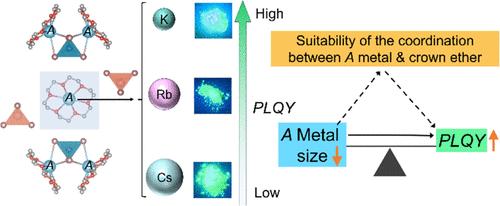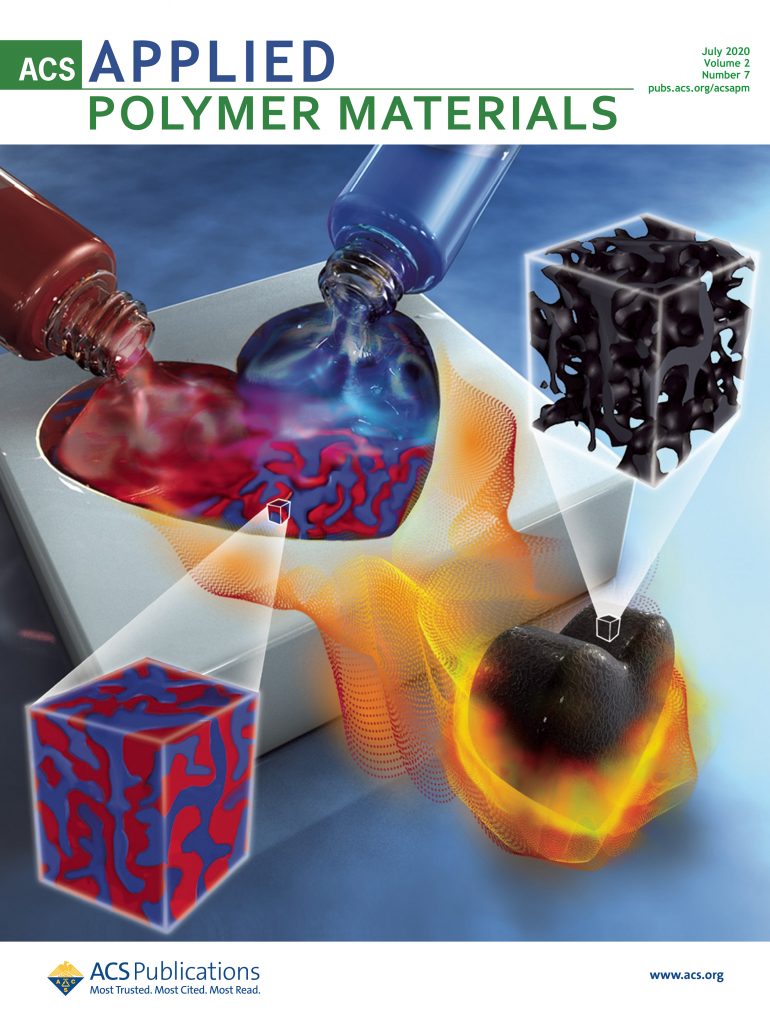Impact of Alkali Metal Coordination on the Photoluminescence Quantum Efficiency Trend in Hybrid Supramolecular Trimetallic Halides
IF 4.4
2区 化学
Q2 MATERIALS SCIENCE, MULTIDISCIPLINARY
引用次数: 0
Abstract
Hybrid supramolecular trimetallic halides with a double-shell clathrate structure belong to a type of functional material with complex compositions and wide tunability. The double-shell structure is generally composed of a crown ether molecule sandwiched between different metal halide units. Here, we synthesize six new hybrid trimetallic halides and their solid solutions with the general formula [(A18C6)3MX4][BX4] (where A = K+, Rb+, Cs+; M = Mn2+ or Mn1–xZnx2+; B = In3+; X = Cl– or Br–), abbreviated as A-M-X. Through the structural analysis of the crystal structure and characterizations of the optical properties of these materials, we have found a direct correlation between the photoluminescence quantum yield (PLQY) and the suitability of the coordination between the A-site metal and the crown ether. Specifically, as the radius of the alkali metal increases (from K to Rb), the PLQY decreases due to poorer suitability. The suitability of the coordination has been analyzed in detail by quantifying the structural parameters (i.e., A–O bond distance, O–A–O bond angle, and distance from A metal to the crown ether center). This trend has been further confirmed via two independent systems using solid solutions through M-site alloying and comparing the chloride and bromide analogs. Surprisingly, a selective coordination mode has surfaced when alloying on the A-site, where the larger alkali metal preferentially coordinates with the connected crown ether instead of the isolated one. This effective approach leads to a wide range of tunability of the PLQY from 21.7 to 95.2% within the total 12 materials. Through further analysis, we have found that the substitution of the A-site metal from K to Cs increases the Mn–X distance, which weakens the crystal field strength of Mn and aligns with the observed trend in PLQY. Our work has further expanded the material space of hybrid trimetallic double-shell clathrates and provides determining insights into controlling the structure and PLQY.

碱金属配位对混合超分子三金属卤化物光量子效率趋势的影响
具有双螺旋结构的混合超分子三金属卤化物属于一种成分复杂、可调性强的功能材料。双壳结构一般由夹在不同金属卤化物单元之间的冠醚分子组成。在此,我们合成了六种新的混合三金属卤化物及其固溶体,通式为[(A18C6)3MX4][BX4](其中 A = K+、Rb+、Cs+;M = Mn2+或 Mn1-xZnx2+;B = In3+;X = Cl- 或 Br-),简称为 A-M-X。通过对这些材料的晶体结构分析和光学特性表征,我们发现光致发光量子产率(PLQY)与 A 位金属和冠醚之间配位的适宜性直接相关。具体来说,随着碱金属半径的增加(从 K 到 Rb),PLQY 会降低,因为配位适宜性较差。我们通过量化结构参数(即 A-O 键距离、O-A-O 键角度以及 A 金属到冠醚中心的距离)详细分析了配位的适宜性。通过两个独立的系统,使用固溶体通过 M 位合金化并比较氯化物和溴化物类似物,进一步证实了这一趋势。令人惊讶的是,在 A 位上进行合金化时,出现了一种选择性配位模式,即较大的碱金属优先与相连的冠醚而不是孤立的冠醚配位。这种有效的方法使得 12 种材料的 PLQY 可调范围很广,从 21.7% 到 95.2%。通过进一步分析,我们发现将 A 位金属从 K 替换为 Cs 会增加 Mn-X 间距,从而减弱 Mn 的晶体场强,这与观察到的 PLQY 趋势一致。我们的工作进一步拓展了混合三金属双壳氯化物的材料空间,并为控制结构和 PLQY 提供了决定性的见解。
本文章由计算机程序翻译,如有差异,请以英文原文为准。
求助全文
约1分钟内获得全文
求助全文
来源期刊

ACS Applied Polymer Materials
Multiple-
CiteScore
7.20
自引率
6.00%
发文量
810
期刊介绍:
ACS Applied Polymer Materials is an interdisciplinary journal publishing original research covering all aspects of engineering, chemistry, physics, and biology relevant to applications of polymers.
The journal is devoted to reports of new and original experimental and theoretical research of an applied nature that integrates fundamental knowledge in the areas of materials, engineering, physics, bioscience, polymer science and chemistry into important polymer applications. The journal is specifically interested in work that addresses relationships among structure, processing, morphology, chemistry, properties, and function as well as work that provide insights into mechanisms critical to the performance of the polymer for applications.
 求助内容:
求助内容: 应助结果提醒方式:
应助结果提醒方式:


